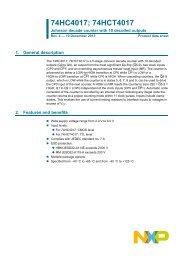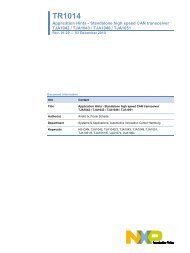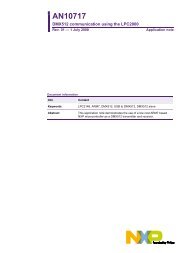AN108711 - NXP Semiconductors
AN108711 - NXP Semiconductors
AN108711 - NXP Semiconductors
You also want an ePaper? Increase the reach of your titles
YUMPU automatically turns print PDFs into web optimized ePapers that Google loves.
Philips <strong>Semiconductors</strong><br />
Figure 1 ISO/IEC 18092 Standard’s Coverage<br />
Application Note<br />
Tips and Tricks for PN51x Integration<br />
The figure also shows that there is no overlapping box in the active part. The active mode<br />
of the NFCIP-1 protocol is completely new, whereas the passive mode has many<br />
similarities with existing standards like ISO/IEC 14443. This document will especially<br />
cover those parts, which reside in the box on the right side (the passive mode with the<br />
backward compatibility to “older” technologies). Some parts of this document also refer to<br />
ISO/IEC 14443-4. Mifare® and FeliCa parts will not be covered in this document.<br />
1.3 ISO/IEC 14443-3A<br />
This standard describes the initialization and anti-collision procedure of contactless<br />
communication between a reader/writer (ISO terminology: PCD) and a card (ISO<br />
terminology: PICC). The physical layer is covered by the ISO/IEC 14443-2 standard,<br />
whereas the transmission protocol is defined in the ISO/IEC 14443-4 standard. The<br />
ISO/IEC 14443-3 covers the activation, both for the types A and B, but here only type A<br />
will be discussed since the type B is not supported by the NFC protocol 4 .<br />
The ISO/IEC 14443-3 standard defines that the card is powered by the RF field. This RF<br />
field is generated by the reader/writer. The PCD always acts as master, which initiates<br />
and controls the complete protocol and data flow.<br />
1.4 ISO/IEC 18092<br />
This protocol is split up into two major parts. In passive mode the Initiator is generating<br />
the RF field and the Target is using load modulation. This approach is compatible with<br />
existing smart card technologies like ISO/IEC 14443-4, Mifare or FeliCa. The second<br />
4 Although type B hasn’t been considered in the NFC protocol, it does not mean that Type B cards may<br />
confuse existing communication.<br />
© Koninklijke Philips Electronics N.V. 2006. All rights reserved.<br />
Application note Rev. 01.10 — 11. May 2006 5 of 37





